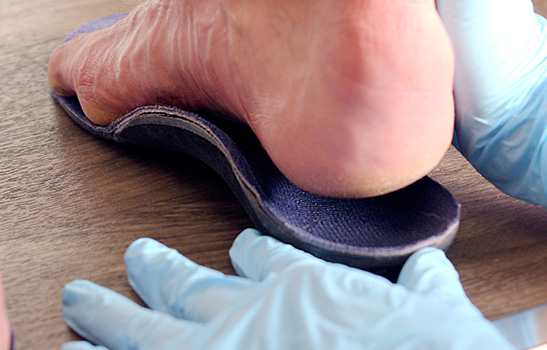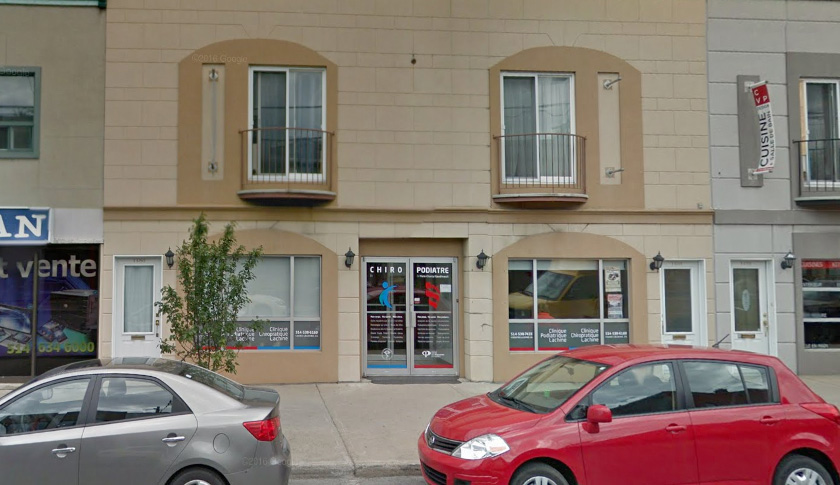Plantar fasciitis
The suffix “-itis” means inflammation. Thus, plantar fasciitis involves the inflammation of the plantar fascia, a ligament located in the arch of the foot between the heel and the toes.
See the causes See the long term complications See how to relieve yourself at home
Signs and symptoms of a plantar fasciitis
- Pain in the heel and/or plantar arch (under the foot)
- Pain typically occurs when you take your first steps in the morning or after a long period of rest
- The pain may get worse over the course of the day or during physical activity
- A lengthening, stretching or tearing sensation under the arch of the foot or on the heel
- Some patients complain of a pin-like sensation under the heel
What are the causes of a plantar fasciitis
1. Poor foot mechanics :
- Flat feet and hyperpronation
- High arches
- Bunions (HAV) and dysfunction of the big toe
- Lack of flexibility in the calf muscles
- Joint hypermobility (excess of flexibility in the foot)
- Leg-length discrepancy
- and others
2. Overstretching of the plantar fascia (the ligament in the arch of the foot) :
- injury
- improper exercise techniques
3. Repeated stress to the ligament :
- sports involving repeated movement like running
- unsuitable footwear
- poor posture at work
- being overweight
All these conditions result in excessive tension being placed on the plantar fascia. Like on an overstretched elastic band, microscopic tears begin to occur, and the resulting swelling (inflammation) can cause pain. The condition occurs most frequently at the insertion site of the ligament to the heel bone, but it can also arise along the entire arch of the foot.
The pain is often greatest when you take your first steps in the morning or after a long period of rest. When you’re resting, the body attempts to repair the microtears. But when renewed pressure is placed on the ligament after a long rest, this repair work is interrupted and pain reoccurs.
Progression and consequences of a plantar fasciitis
The plantar fascia is the most important ligament for supporting the plantar arch and is involved in all movements of the foot. For this reason, once the condition sets in, it tends to worsen. Pain may initially be felt only after a period of rest but may eventually persist throughout the entire day and impact your everyday activities. The condition forces many athletes to slow down or even stop their training.
Left untreated, the problem can become chronic as the ligament thickens with fibres that are weaker and less organized, making you prone to re-injury. If the stress continues without treatment, a partial or complete tear of the plantar fascia may occur.
Over time, the excess tension at the insertion site of the plantar fascia to the heel bone (calcaneus) can result in a bony outgrowth called a calcaneal spur (or heel spur).
Pain under the foot can also lead to unconscious changes in gait or posture and generate referred pain in other parts of the body, like the outer heel, leg, knee, hips or back.
How to relieve the pain of a plantar fasciitis at home
There are three aspects to treating plantar fasciitis:
1. Improving foot mechanics :
- Wear laced shoes with a low heel like running shoes as often as possible, even at home.
- Fit your shoes with insoles with arch support.
- Reduce physical activity.
2. Treating inflammation :
- Apply ice to the painful area 10-15 minutes every evening and throughout the day as needed. Tip: Freeze a bottle of water, then place it on the floor and massage the painful area by rolling under the foot.
3. Stretching exercises :
- Warm up your feet when you step out of bed in the morning. Stand on your tiptoes, make circular movements, raise your foot with your toes up to stretch the calf muscle.
- Massage the arch of the foot using a golf or tennis ball for 5 to 10 minutes
- Stretch your calves every morning and every evening. You can use a wall, step or towel as a prop.
Diagnostic of a plantar fasciitis
- To identify whether poor foot alignment or posture may be at fault, a thorough biomechanical exam is essential. The exam involves a full assessment of the foot’s mechanics, including movement, posture and gait. Afterwards, a comprehensive gait analysis is conducted using pressure sensors connected to cameras.
- X-rays must be conducted to eliminate other causes of heel pain and identify the presence of a calcaneal (heel) spur. X-rays also make it possible to assess the alignment of the bones in the foot.
- Ultrasound is an excellent imaging technique that can be used to diagnose plantar fasciitis, establish its severity and help design a treatment plan. This radiation-free technique allows us to observe the inflamed area, measure the thickening of the fascia, assess its fibre structure and determine whether tears are present. It also allows us to rule out other conditions affecting the surrounding structures.
What can my podiatrist do about a plantar fasciitis
After making a diagnosis and identifying the specific causes of the problem, your podiatrist will help you set up an action plan, offer you a range of tools and follow up on your condition.
The most common solutions used by podiatrists include:
1. Plantar orthotics :
Used to treat and prevent plantar fasciitis caused by biomechanical factors, they optimize foot mechanics, prevent overstretching of the plantar fascia and much more. Find out more about orthotics.
2. Ultrasound-guided cortisone injections :
When the inflammation is severe or fails to clear up, cortisone is the best technique for “putting out the fire”. Instead of administering an anti-inflammatory drug in pill form, cortisone is placed in the exact trouble spot with the guidance of ultrasound technology.
3. Radial shockwave therapy :
Used in chronic cases where patients fail to respond to treatment, this therapy uses the body’s natural capacities to restart the healing cycle. It works a bit like a time machine. This therapy is successful in 80-90% of chronic cases. Find out more about shockwave therapy.
4. Prescription medication :
Painkillers, muscle relaxants and/or anti-inflammatory drugs are sometimes prescribed.
5. Physical therapy :
- Manipulative therapy
- Neurocryotherapy and ultrasound
- Taping
- Night socks, splints and walking shoes
How to prevent a plantar fasciitis?
- Wear appropriate footwear.
- Wear your prescribed orthotics daily to help prevent recurrence of the condition.
- Replace your shoes and work boots annually.
- Wear sandals or running shoes at home when spending long periods standing (while cooking, etc.).
- Take action at the first sign of pain to prevent long-term problems (See “Treating the condition at home”).
- If overweight, consider losing weight.
- Warm up well before doing sports or other physical activities.
- After exercising, stretch your calves and the backs of your legs.
- Follow a progressive workout plan, particularly if you run.
- Do a variety of exercise types. If running, run on a variety of surfaces (grass, dirt track, etc.).
- Replace running shoes if they wear down or after each 800-1,000 km of use. If your shoes are more lightweight or if you have a larger body mass, you may need to replace your shoes after 500-700 km. Generally speaking, if you start feeling discomfort that wasn’t there previously, it’s often a sign that you need to replace your shoes.
If I feel piercing pain under the heel, it must be a calcaneal (heel) spur.

Many people who suffer from plantar fasciitis say they feel pain directly at the heel bone, as if they were walking on a sharp point. However, the true cause of pain is the attachment of the ligament to the heel bone. Even in cases where a calcaneal (heel) spur is actually present, the ligament is still the cause of pain. Therefore, there's no point in wearing a foot pad with a hole under the heel to "protect the spur”.
And if it was not a plantar fasciitis?
There are a number of other conditions that can cause symptoms similar to those of plantar fasciitis:
- Torn plantar fascia
- Infracalcaneal bursitis
- Abductor hallucis myositis
- Calcaneus stress fracture
- Plantar fascia calcification
- Plantar fibroma
- Baxter’s neuritis (irritation of a nerve under the foot)
- Referred pain (inflammation of the sciatic nerve or lumbar compression)
- Panniculitis (inflammation of the fatty layer under the heel)
- Tumour mass of the heel bone
- Systemic disease (rheumatoid arthritis, fibromyalgia, psoriatic arthritis, ankylosing spondylitis, etc.)


